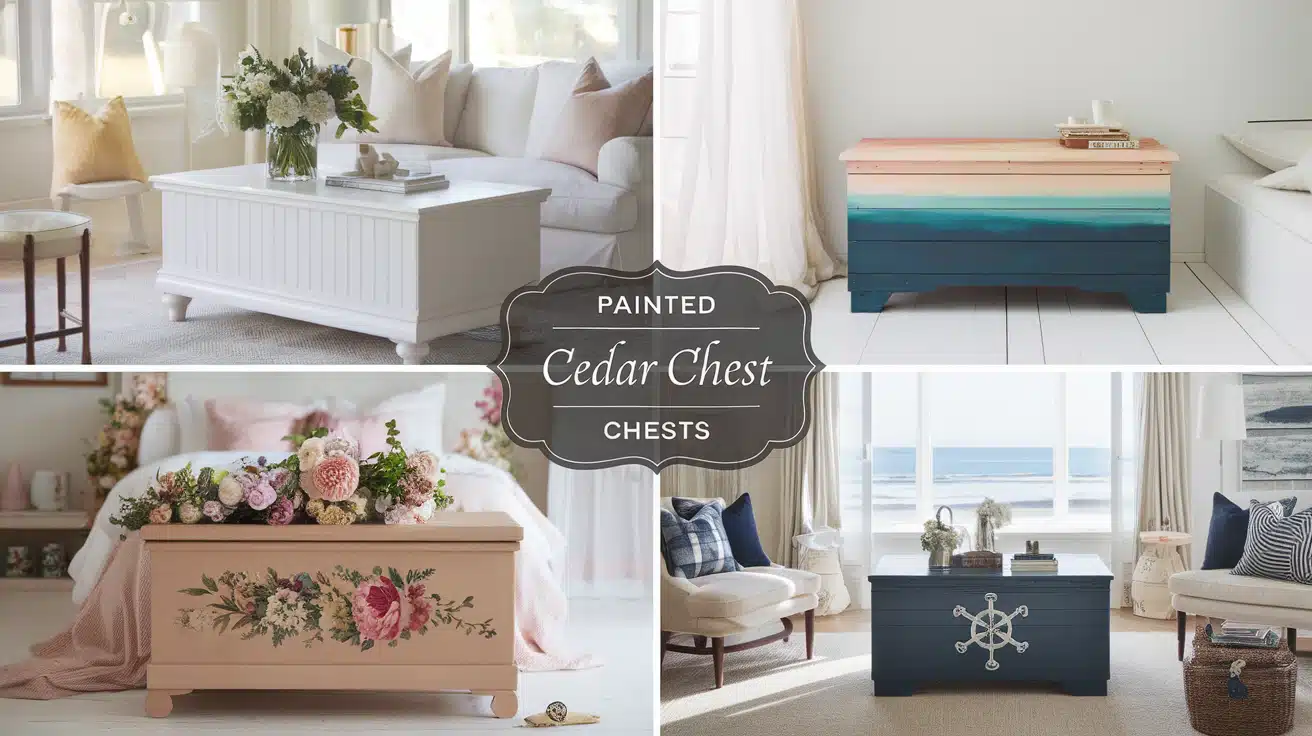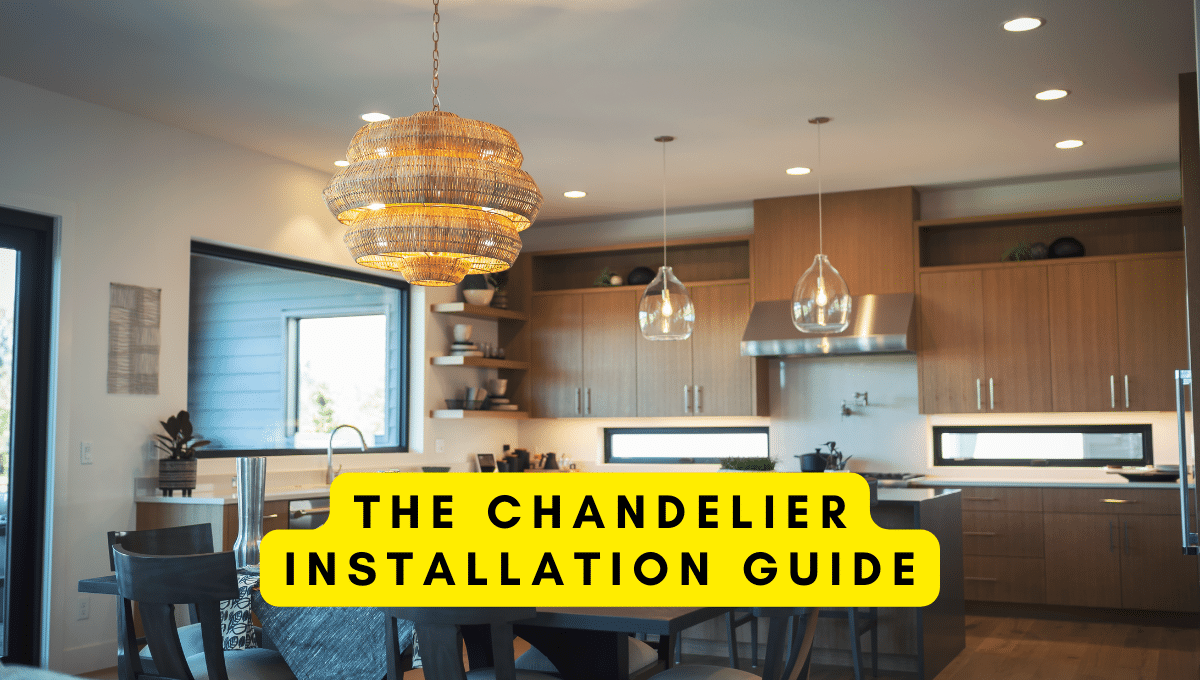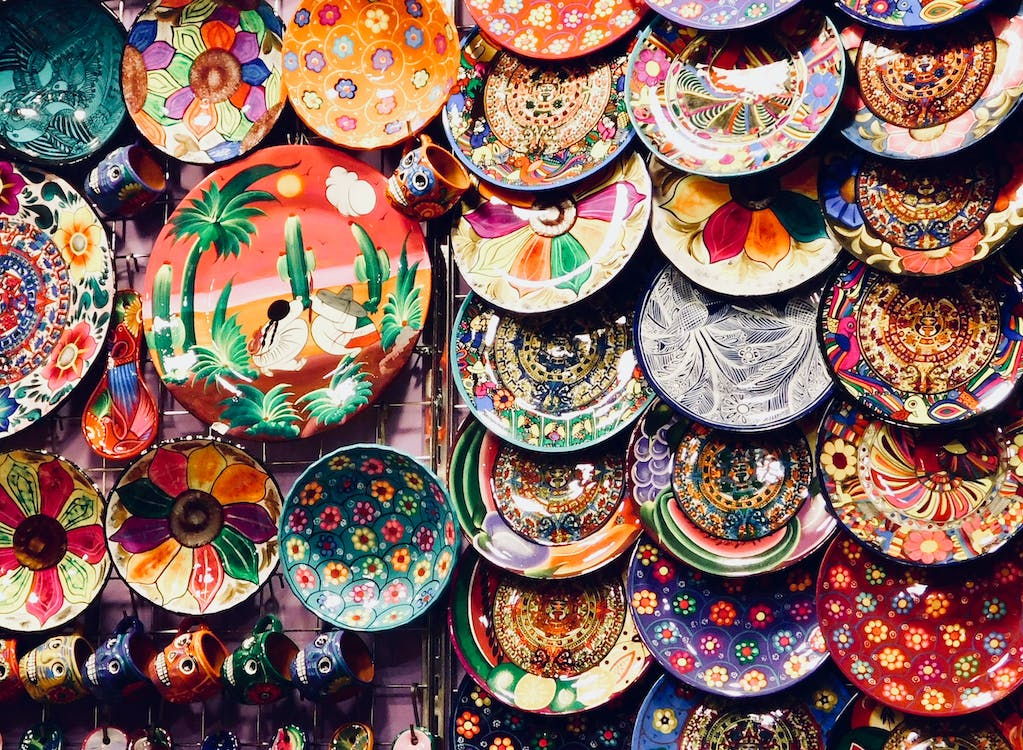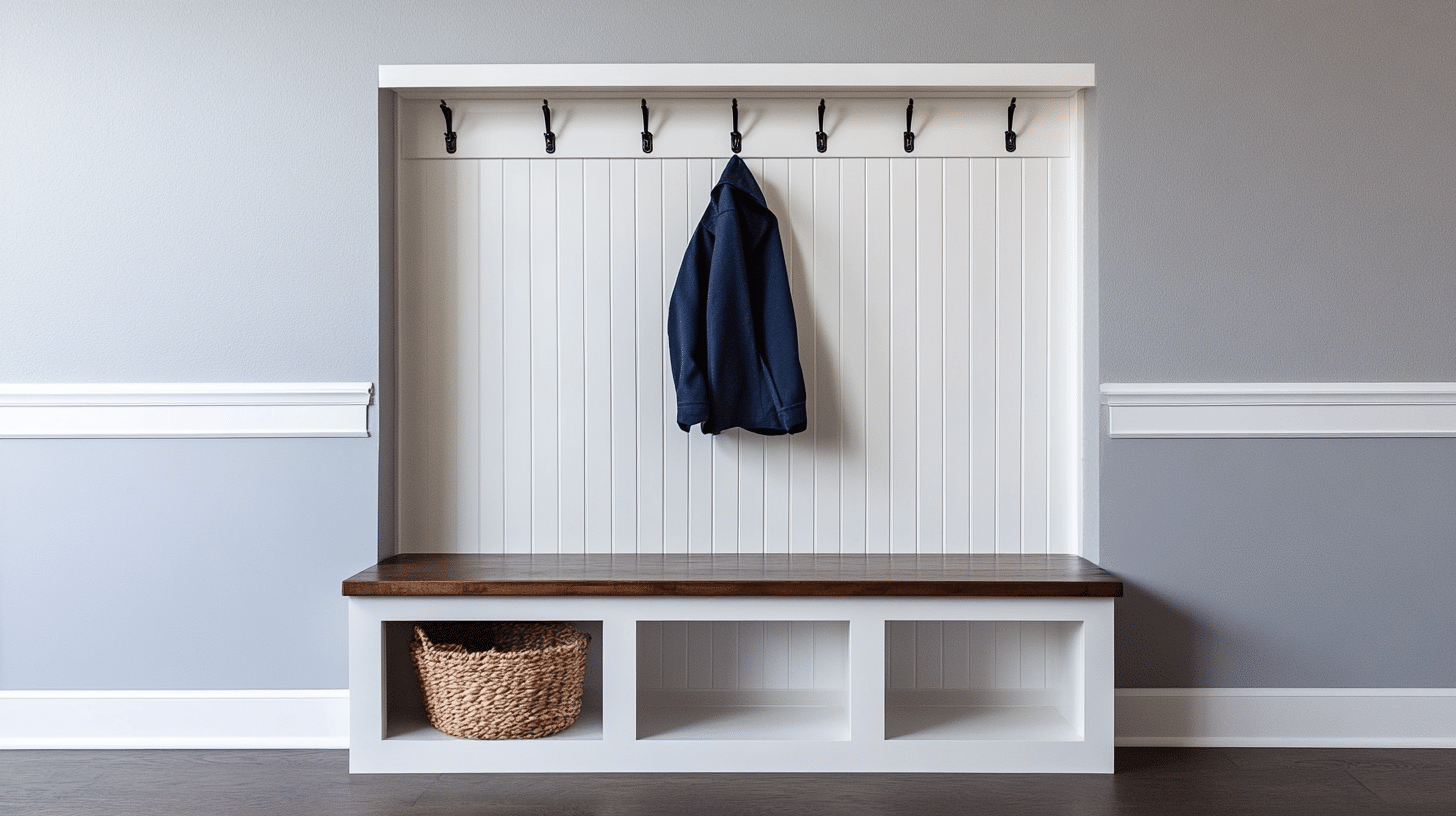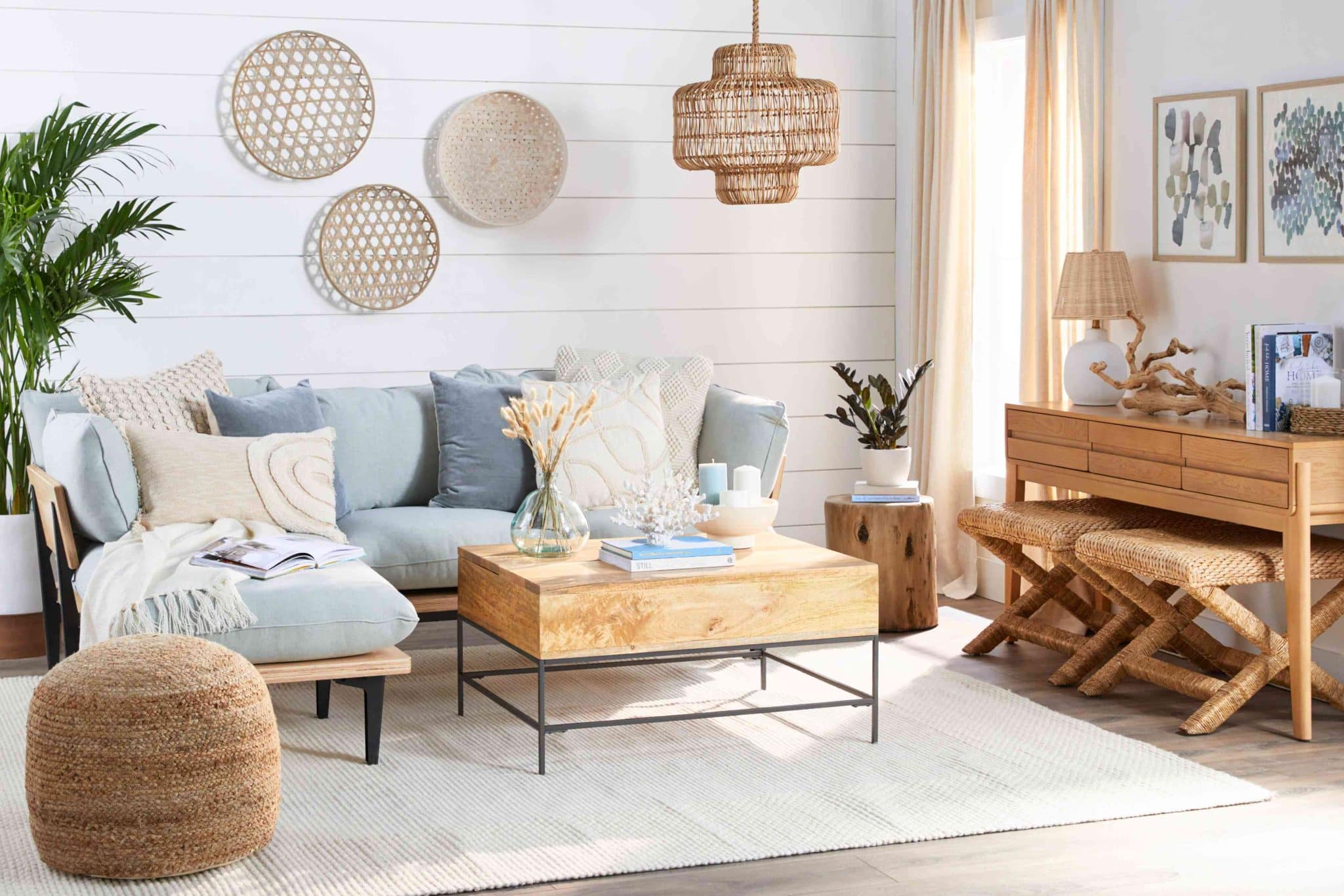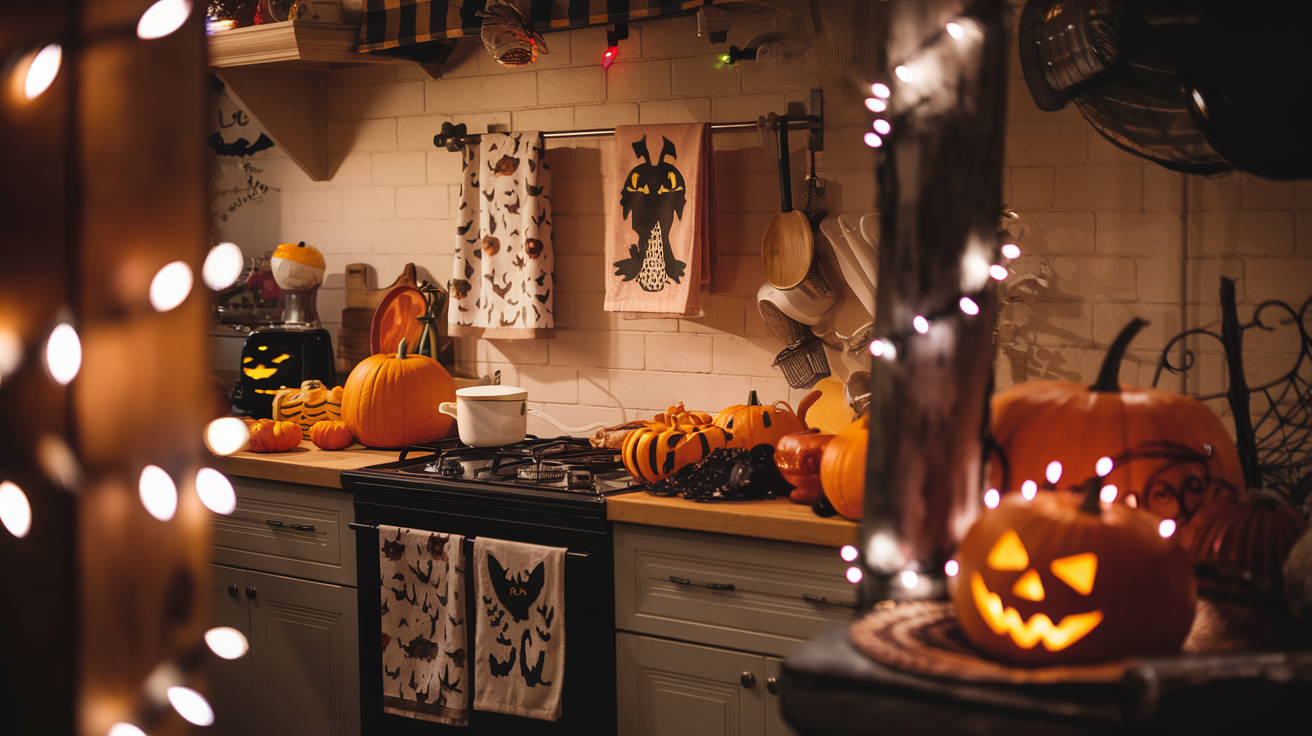21 Creative Painted Cedar Chest Ideas for Your Home
After renovating hundreds of cedar chests over the years, I’ve discovered that paint can breathe new life into these cherished pieces.
Each chest tells its own story, and through careful painting techniques, we can preserve their character while adding fresh style.
Let me share my experience transforming these traditional storage pieces into stunning focal points.
Why Paint a Cedar Chest?
Through years of restoration work, I’ve found that painted cedar chests:
- Adapt to modern decor styles
- Hide minor damage while preserving the structure
- Create unique statement pieces
- Maintain functionality while adding beauty
- Allow for personal expression in design
Painted Cedar Chest Ideas
1. Classic White Transformation
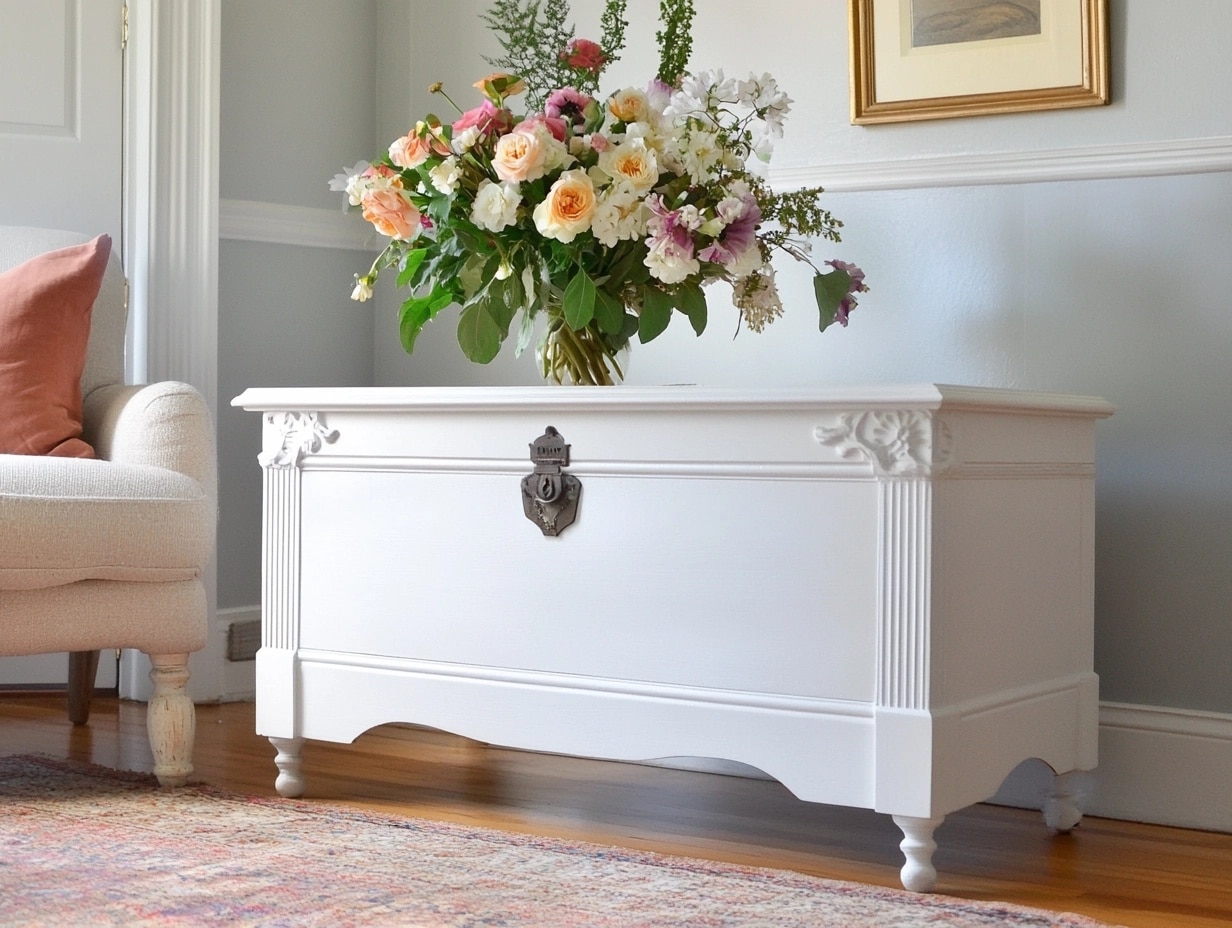
I transformed a vintage cedar chest into a timeless piece using pure white paint that brightens any room.
The original chest showed signs of wear, but careful preparation and multiple paint layers created a flawless finish that looked factory-fresh.
The white finish beautifully highlights the chest’s original hardware while maintaining its classic lines.
Special attention to corner details and edges ensures professional, lasting results.
Application Process:
- Clean the surface thoroughly with wood cleaner
- Sand existing finish carefully
- Apply oil-based primer for proper adhesion
- Layer multiple thin coats of white paint
- Seal with a clear protective finish
2. Ombre Effect Creation
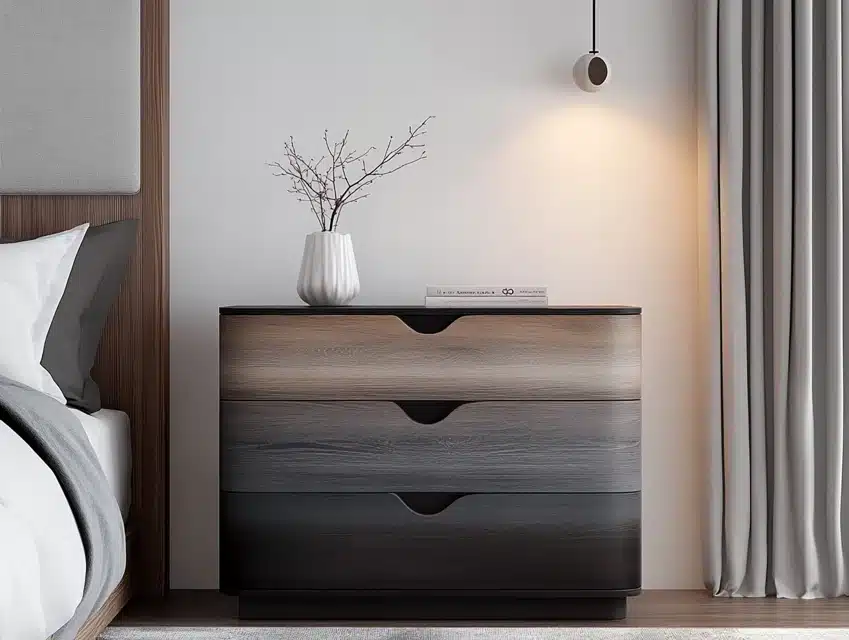
I discovered the magic of ombre effects when a client requested something unique for her daughter’s bedroom.
My first attempt at an ombre finish taught me patience and created the best color transitions.
The chest transformed from light gray at the top to deep charcoal at the bottom, creating a stunning focal point.
Each shade blends perfectly into the next, creating an illusion of flowing color.
Visitors often ask how I achieved such smooth color transitions in this piece.
DIY Steps:
- Sand the entire surface thoroughly using medium-grit sandpaper first.
- Mix five graduated paint shades before starting work.
- Apply the base coat evenly across the entire chest surface.
- Work in small sections while blending each color.
- Keep edges wet for seamless color transitions always.
- Spray a light mist of water between color layers.
- Apply three protective clear coats after complete drying.
3. Chalk Paint Revival
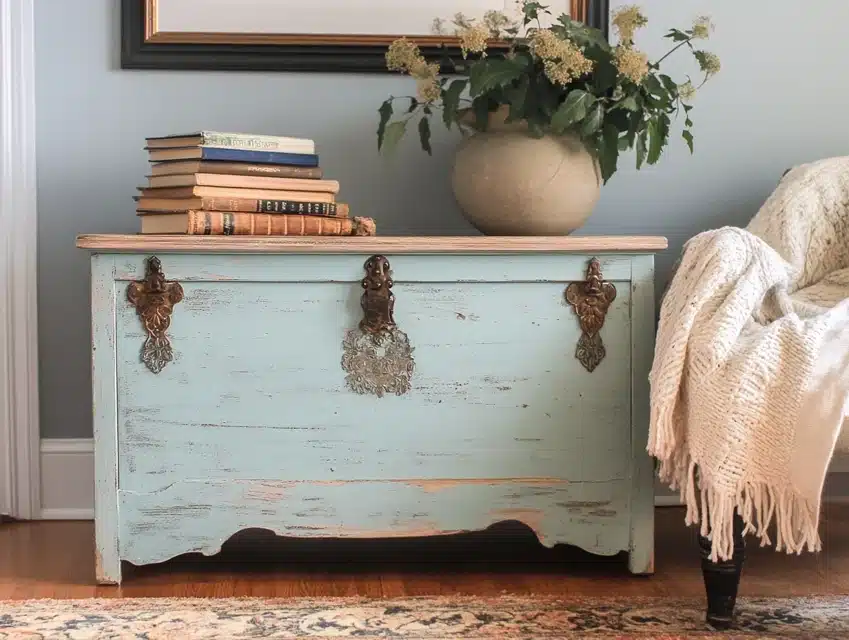
I remember the first cedar chest I transformed with chalk paint – it belonged to my grandmother.
The soft, matte finish revealed details I hadn’t noticed in years.
Light distressing along the edges revealed hints of the original wood, adding character and depth.
The piece now serves as storage and a conversation starter in my living room.
Even after years of use, the finish maintains its vintage charm perfectly.
DIY Steps:
- Clean the surface completely with a degreaser and wood cleaner.
- Apply the first chalk paint coat in long strokes.
- Sand the entire surface lightly between paint applications.
- Distress edges and corners with medium-grit sandpaper.
- Apply dark wax into corners for an aged effect.
- Buff the entire surface with a soft cloth until smooth.
- Seal with clear wax using circular motions.
4. Geometric Pattern Innovation
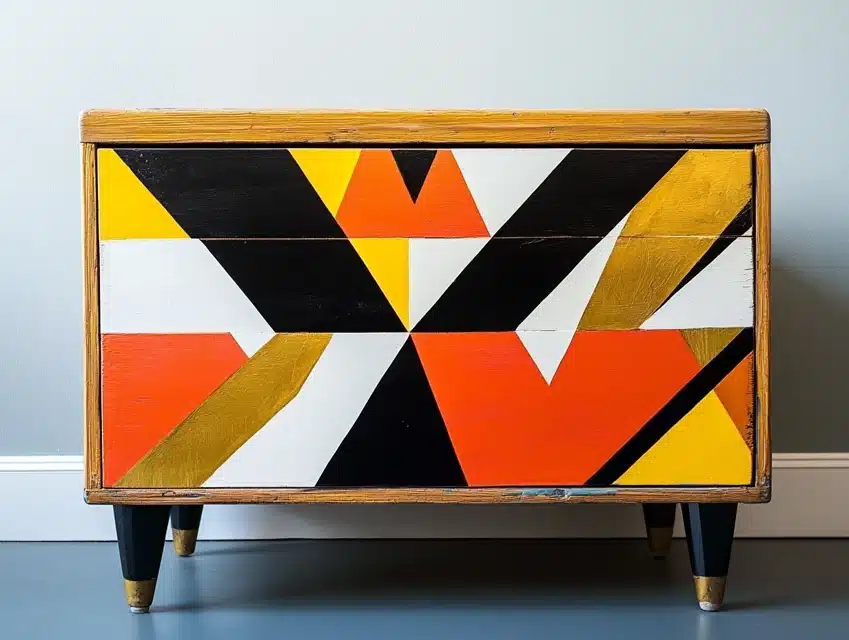
A client’s modern loft-inspired me to try bold geometric designs on a traditional chest.
The combination of sharp lines and bright colors transformed the piece into modern art.
Each triangle required precise measuring and taping, but the result proved worthwhile.
The finished chest became the focal point of their minimal living space.
Other designers have even asked about my technique for achieving such clean lines.
DIY Steps:
- Create precise paper templates for each geometric shape.
- Apply painter’s tape following template measurements exactly.
- Paint each section carefully with an angled brush.
- Remove the tape while the paint remains slightly wet.
- Touch up any bleeding with a small artist’s brush.
- Sand between coats for a smooth finish always.
- Apply water-based polyurethane for a lasting protection finish.
5. Nautical Theme Creation
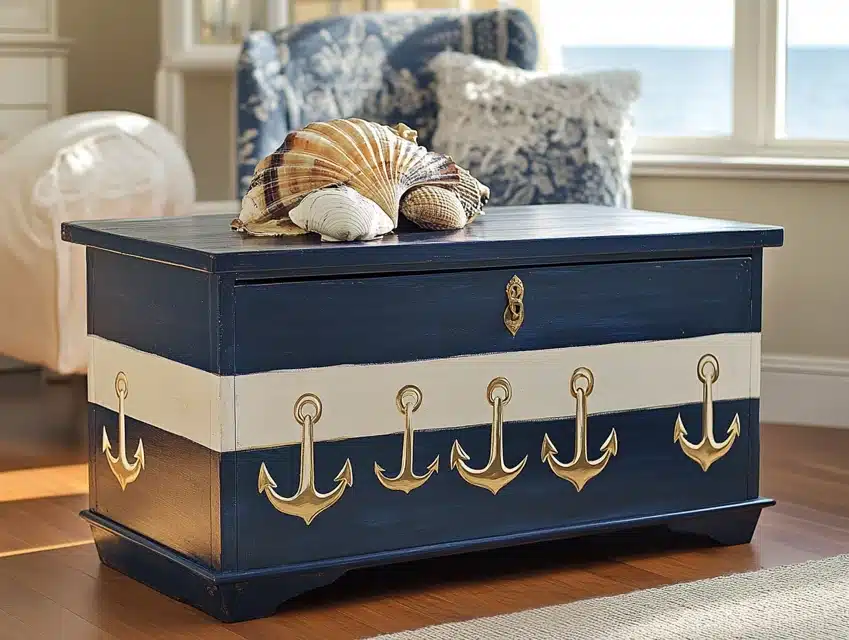
My beach house client inspired this transformation of a weather-worn chest.
The deep navy blue base reminded everyone of ocean depths.
Crisp white stripes created perfect contrast against the dark background.
Hand-painted anchors in metallic gold added unexpected luxury touches.
The finished piece brought maritime charm to their coastal living room.
DIY Steps:
- Clean the surface thoroughly with a specialized wood cleaner first.
- Apply two coats of navy blue paint base.
- Measure and tape straight lines for perfect stripes.
- Paint white stripes carefully with a small foam roller.
- Create anchor stencils using contact paper precisely.
- Apply metallic details with proper artist brushes.
- Seal the entire piece with a marine-grade protective coating.
6. Two-Tone Style Statement
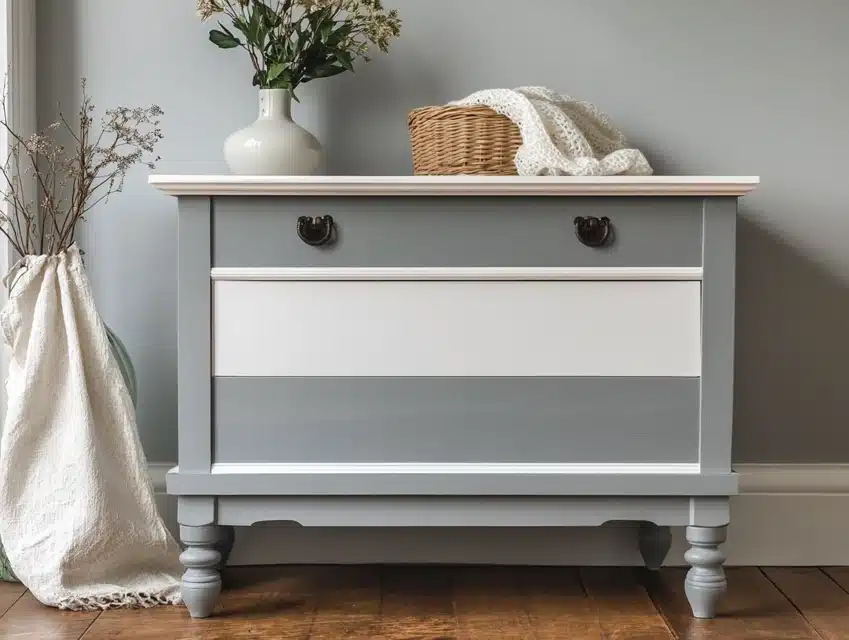
A modern farmhouse renovation taught me about two-tone impact.
The combination of soft gray and crisp white created a stunning contrast.
Each color defined different sections of the chest perfectly.
Special attention to the transition line made this piece exceptional.
The finished chest inspired three more similar commissions that year.
DIY Steps:
- Sand the entire piece to create a smooth painting surface.
- First, apply an oil-based primer for superior paint adhesion.
- Tape transition lines between colors with precision.
- Paint lighter colors first using the proper technique.
- Apply a darker shade after completely drying the base.
- Remove the tape while the second color remains slightly wet.
- Protect the finish with three clear polyurethane coats.
7. Floral Stencil Enhancement
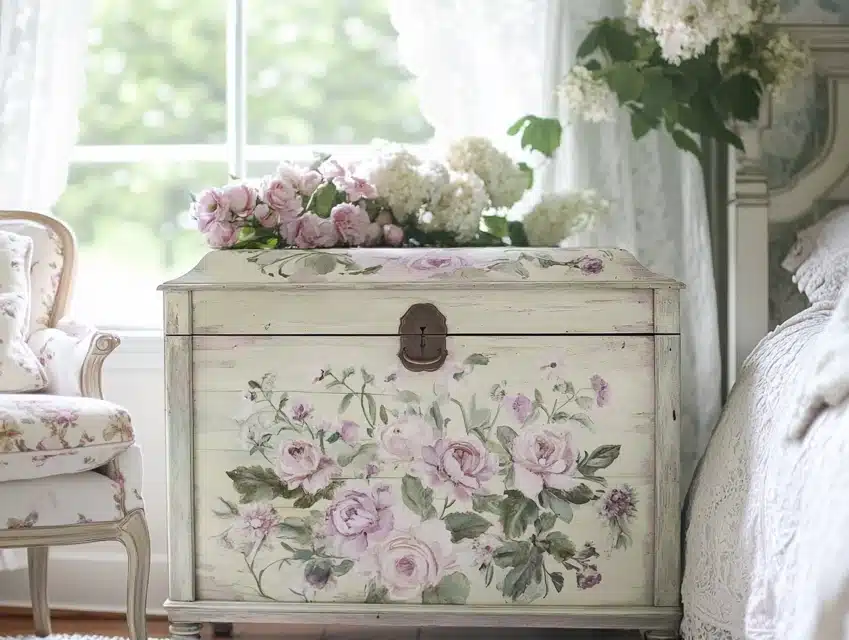
My sister’s vintage chest became my first stencil experiment.
Delicate flower patterns transformed the plain surface completely.
Each stenciled section required careful color coordination choices.
The layered design created unexpected depth and movement.
This piece now serves as my portfolio’s most-requested design.
DIY Steps:
- Prepare the surface with proper sanding and cleaning techniques.
- Apply solid base color in thin, even coats.
- Position stencils carefully using proper measuring tools.
- Secure edges completely with low-tack painter’s tape.
- Apply stencil paint using a special stippling brush.
- Layer multiple colors for a dimensional floral effect.
- Seal design with a water-based protective clear coat.
8. Rustic Distressed Creation
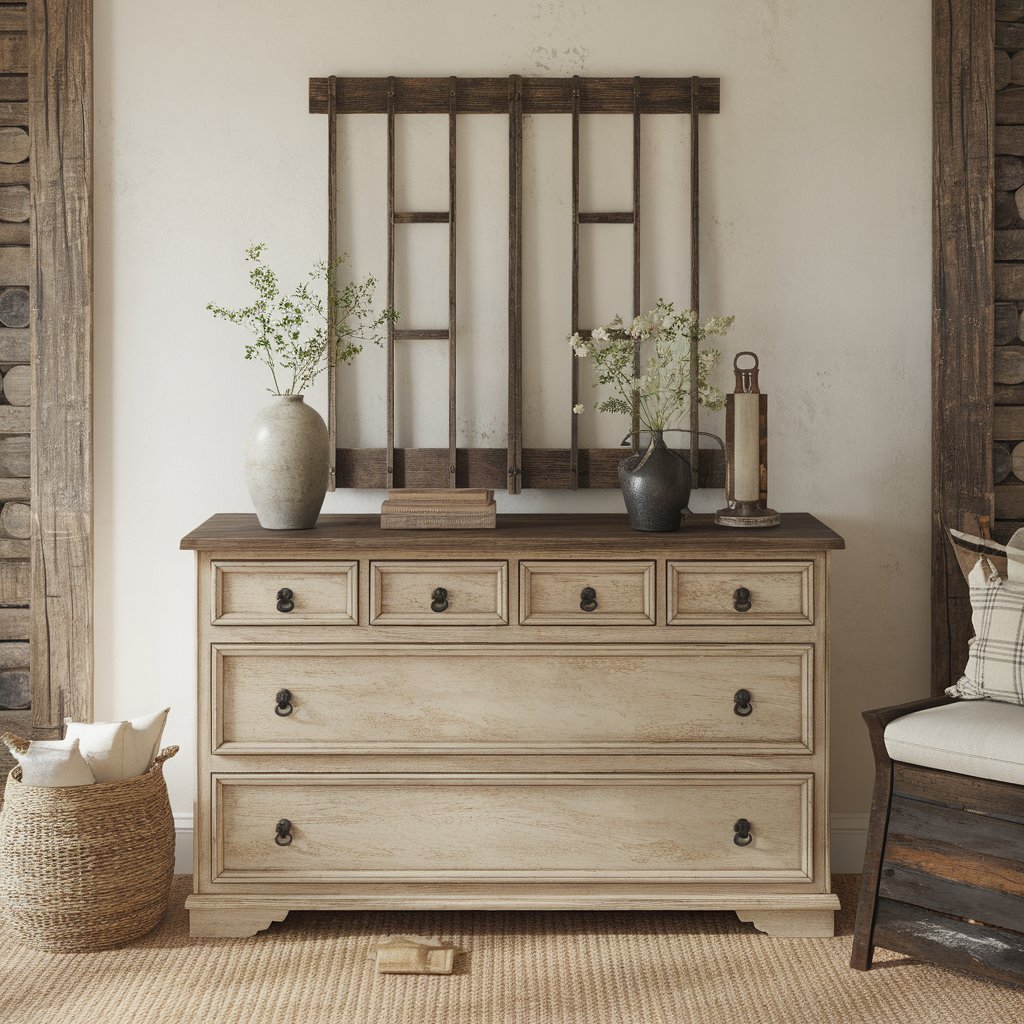
My favorite distressed finish came from an old family chest.
The original dark wood peeked through the cream-colored paint perfectly.
Natural wear patterns guided my distressing technique locations.
Each sanded edge tells a story of generations past.
The piece inspired an entire collection of aged furniture finishes.
DIY Steps:
- Begin with a thorough cleaning of the entire wood surface.
- Apply a dark base coat for a peek-through color effect.
- Layer light-colored paint over a completely dried base.
- Sand edges and corners with varying pressure levels.
- Create authentic wear patterns in high-touch areas.
- Add dark wax carefully to enhance distressed areas.
- Seal with a matte finish for an authentic, aged appearance.
9. Vibrant Color Statement
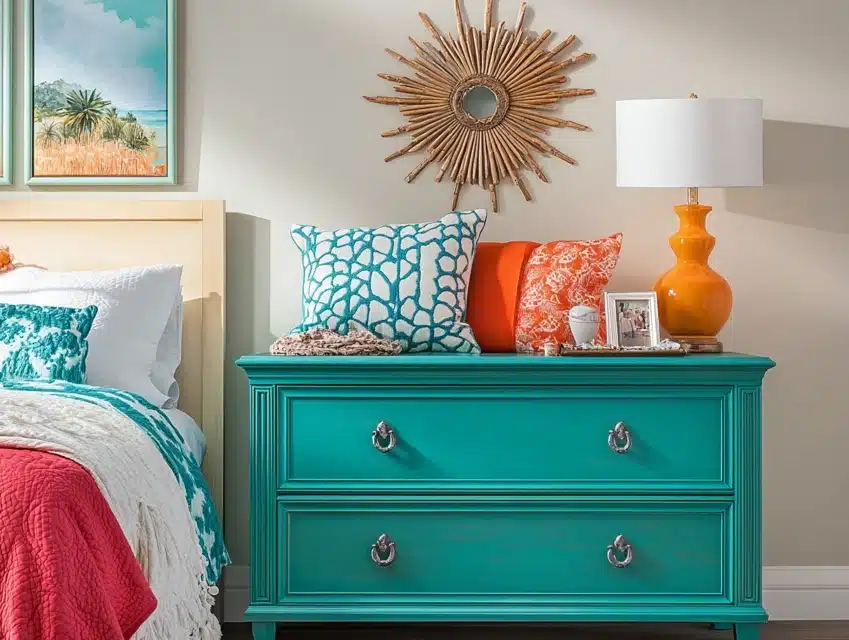
A client’s bold vision challenged my traditional painting approach.
The bright teal color transformed their neutral bedroom completely.
Careful preparation ensured the vibrant shade stayed true.
Multiple thin coats gradually created perfect color depth.
This chest became the room’s most striking conversation piece.
DIY Steps:
- Prime the surface thoroughly with stain-blocking primer first.
- Test color saturation on the hidden chest area.
- Apply bright color in multiple thin layers.
- Sand lightly between each coat for smoothness.
- Build color depth through progressive paint applications.
- Check the evenness of color in different lighting conditions.
- Protect vibrancy with a UV-resistant clear top coat.
10. Personalized Monogram Addition
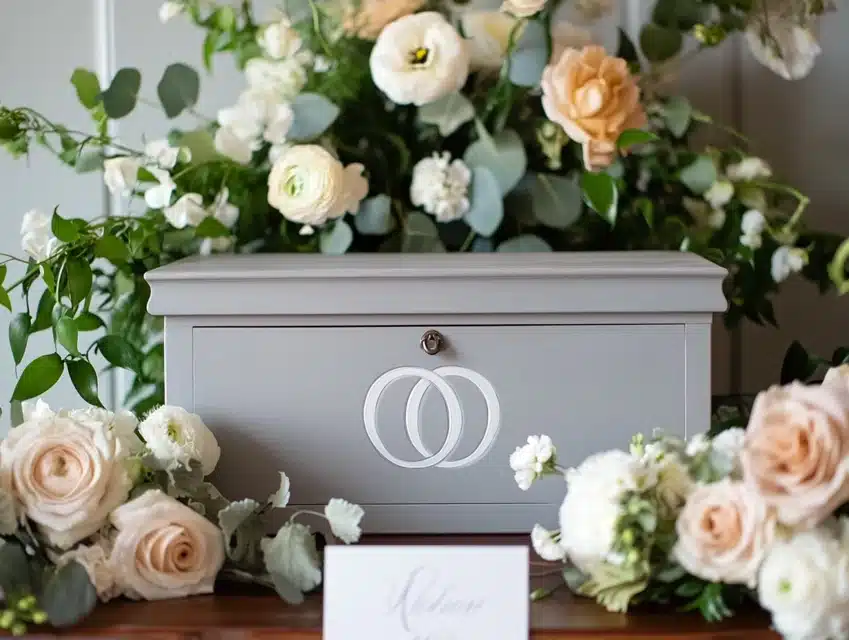
A wedding gift commission taught me about meaningful personalization.
The classic gray background highlighted the monogram beautifully.
Custom stencil creation ensured perfect letter proportions always.
The couple’s initials became the chest’s central focal point.
This piece inspired many similar anniversary gift commissions later.
DIY Steps:
- Create a precise monogram template using proper spacing.
- Apply solid background color in even coats first.
- Position custom stencils with careful measurement techniques.
- Paint letters using a small brush for crisp edges.
- Remove the stencil while the paint remains slightly wet.
- Touch up any bleeding with a fine detail brush.
- Apply a clear protective coat over the entire surface.
11. Antique Gold Statement Piece

My most challenging goldwork transformation began with a damaged cedar chest from an estate sale.
The original finish had completely deteriorated, but the bones of the piece remained strong and beautiful.
Creating the perfect antique gold finish required multiple layers of metallic shades and glazes.
Each layer added depth and character, building a finish mimicking centuries-old gilding.
The natural wear patterns in the wood enhanced the aged gold effect beautifully.
This piece taught me that imperfections often create the most authentic antique appearances.
The finished chest now holds court in a client’s formal living room, often mistaken for a European antique.
DIY Steps:
- Prepare the surface meticulously with fine-grit progression sanding.
- Apply specialized metallic primer for proper gold adhesion.
- Layer different gold shades for an authentic depth appearance.
- Create an aged patina carefully using special glazing techniques.
- Highlight raised areas with the brightest gold shade gently.
- Add dark wax in recessed areas for age definition.
- Seal with a clear coat designed for metallic finishes.
12. Hand-Painted Artistic Vision
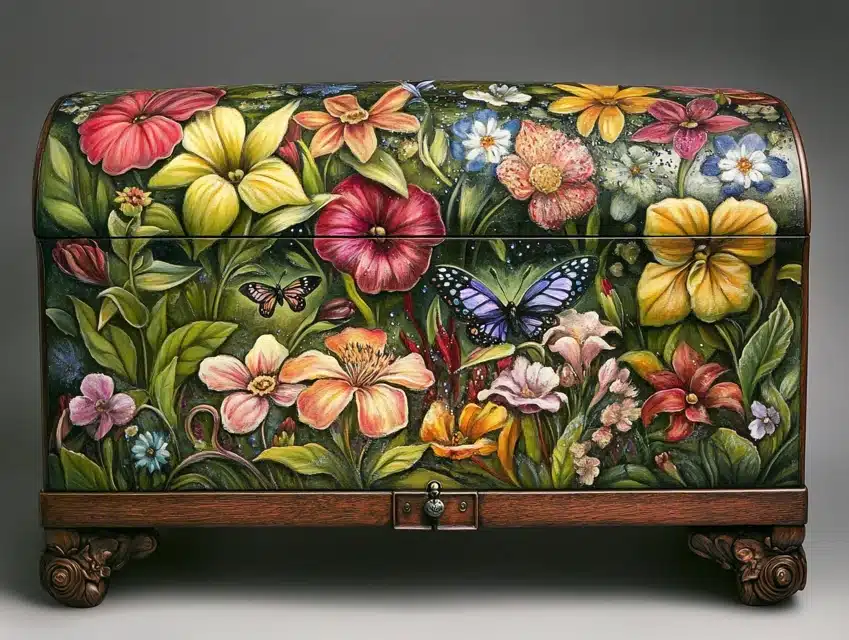
A client’s request for a garden scene pushed my artistic boundaries completely.
Each flower and leaf required careful planning and color mixing for a natural appearance.
The landscape wrapped around all sides of the chest, creating a continuous garden scene.
Small details like butterflies and dewdrops brought the painting to life unexpectedly.
The changing light throughout the day reveals different aspects of the detailed work.
This project took over forty hours but resulted in a true family heirloom piece.
Years later, the client still sends photos of their grandchildren, who are discovering new painting details.
DIY Steps:
- Sketch the entire design carefully on paper first.
- Create a smooth white base for the artwork foundation.
- Transfer the design outline carefully using transfer paper.
- Build background colors in light-to-dark progression.
- Add detail work using a specialized artist brush collection.
- Layer a clear coat between detail work for protection.
- Apply the final protective coating designed for the artwork.
13. Decoupage Design Integration
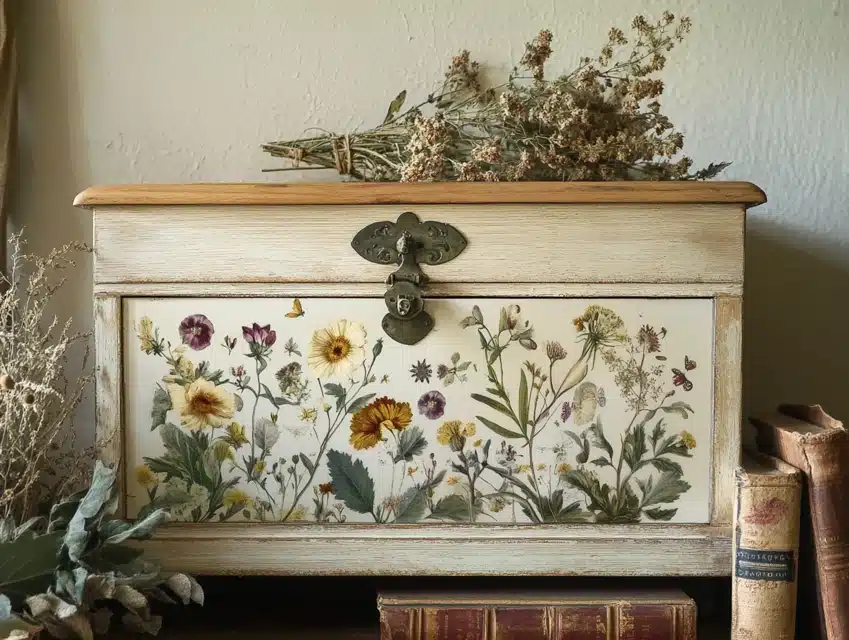
This technique combines my love of painting with paper artistry perfectly.
The chest started as a simple cream base but evolved into an artistic collaboration.
Vintage botanical prints layered between paint created unexpected depth and interest.
Each paper element required precise cutting and positioning for seamless integration.
Special attention to edge treatment ensured no visible paper lines remained.
The finished piece captures attention from every angle in the room.
Multiple clear coats protect the delicate paper elements while maintaining visual depth.
DIY Steps:
- Choose complementary papers and paint colors carefully first.
- Prepare the surface with a smooth base coat application.
- Cut paper elements with extreme precision using templates.
- Carefully apply paper pieces using a specialized decoupage medium.
- Paint connecting areas to blend with paper elements.
- Remove all air bubbles using proper smoothing tools.
- Build up protective layers carefully with the decoupage sealer.
14. Chalkboard Surface Creation
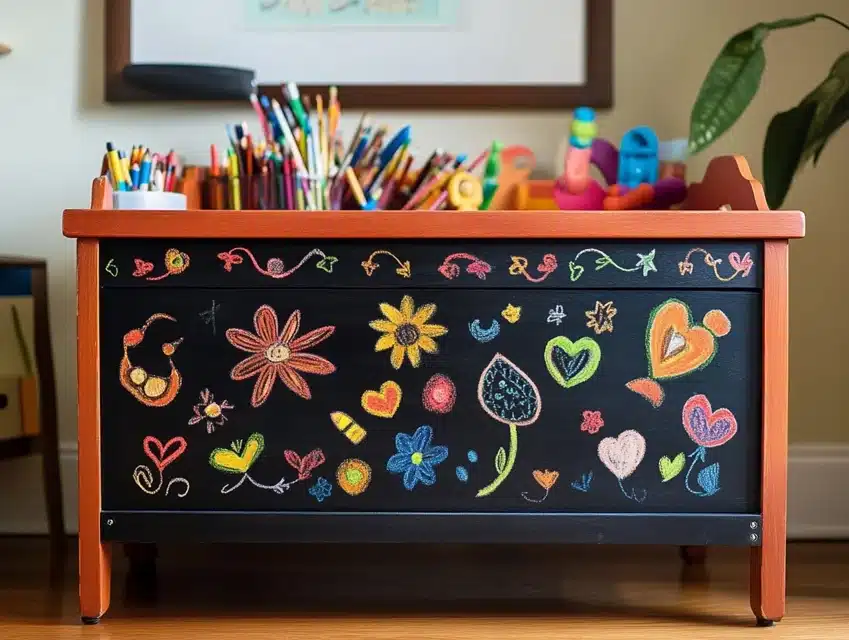
This transformation began when a young mother wanted interactive storage for her playroom.
The entire chest surface became a canvas for daily creativity and expression.
Special attention to the base preparation ensured perfect chalk adhesion and erasability.
Hidden compartments inside still maintain the cedar protection for stored items.
The finished piece serves both as functional storage and an endless artistic outlet.
Children’s artwork decorates the surface while treasures stay protected inside.
The chalkboard surface maintains its perfect writing texture even after years of use.
DIY Steps:
- Strip the existing finish completely using a chemical stripper first.
- Sand the surface until completely smooth with fine grit.
- Apply specialized chalkboard primer in thin layers carefully.
- Build up chalkboard paint surface using the proper technique.
- Season the entire surface with chalk dust thoroughly.
- Create designated areas for permanent vs temporary art.
- Protect edges and interior with clear cedar-safe sealer.
15. Modern Minimalist Design
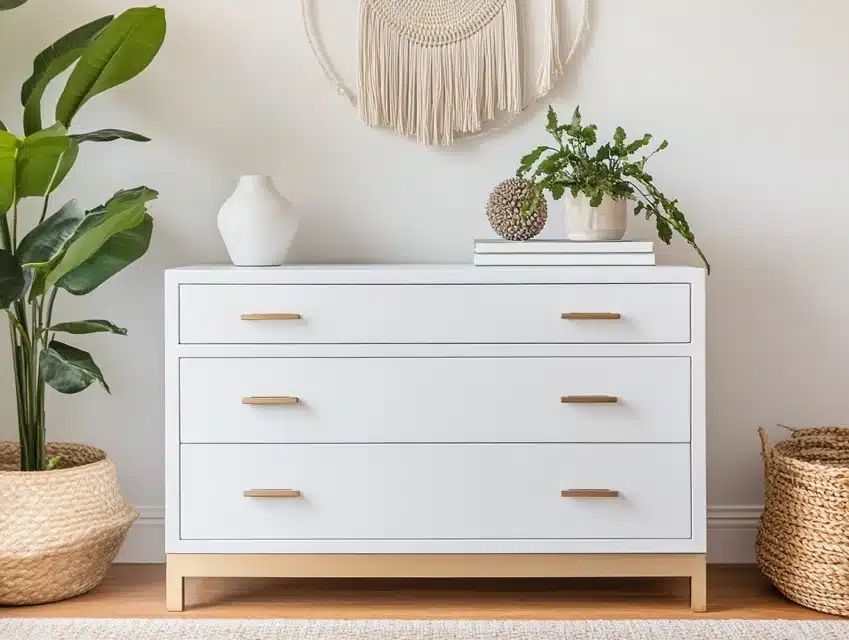
A contemporary apartment renovation inspired this streamlined transformation.
The clean lines of the original chest guided my color and finish choices.
Pure white paint with a matte finish eliminated any surface distraction.
Simple brass hardware replaced the original pieces for subtle sophistication.
This piece proves that sometimes, the simplest approach creates the strongest impact.
DIY Steps:
- Clean the surface thoroughly with degreasing wood cleaner first.
- Apply high-adhesion primer specifically for modern finishes.
- Sand between coats using ultra-fine grit paper.
- Build up a pure white color with thin layers.
- Install modern hardware with precise measurements always.
- Create a perfect edge finish with light distressing.
- Seal with matte protective coating for durability.
16. Striped Pattern Implementation
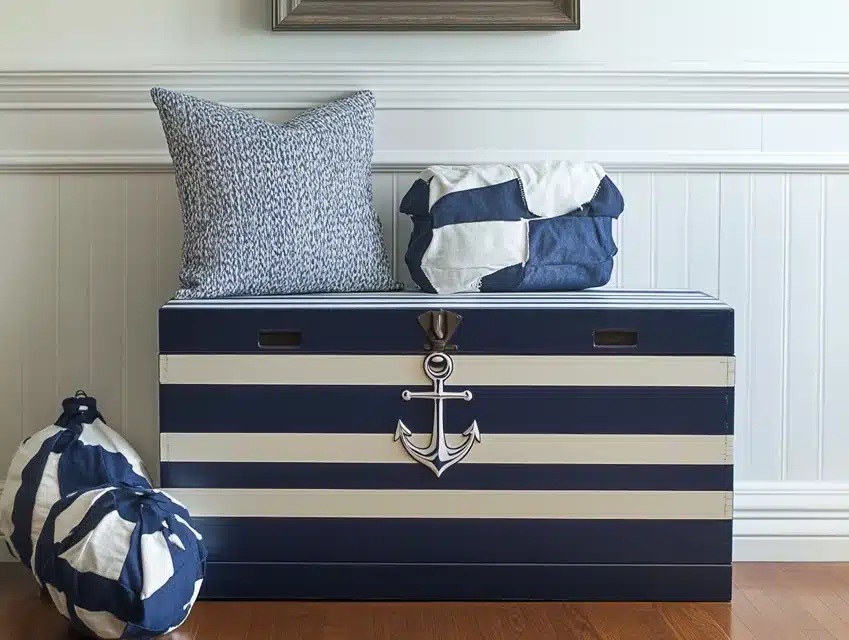
This project taught me the importance of precise measuring and patience.
Each stripe required careful planning to maintain perfect width and spacing.
The alternating navy and white stripes created a dramatic visual impact.
Special attention to corners ensured unbroken pattern flow around edges.
This chest inspired an entire collection of striped furniture pieces later.
DIY Steps:
- Measure and mark all stripe positions with a laser level.
- Apply the base coat in the lightest stripe color first.
- Create precise tape lines using specialized edge tape.
- Paint darker stripes with the proper brush technique.
- Remove the tape while the paint remains slightly wet carefully.
- Touch up any bleeding edges with a detail brush.
- Apply a clear protective coat over the entire surface carefully.
17. French Provincial Elegance
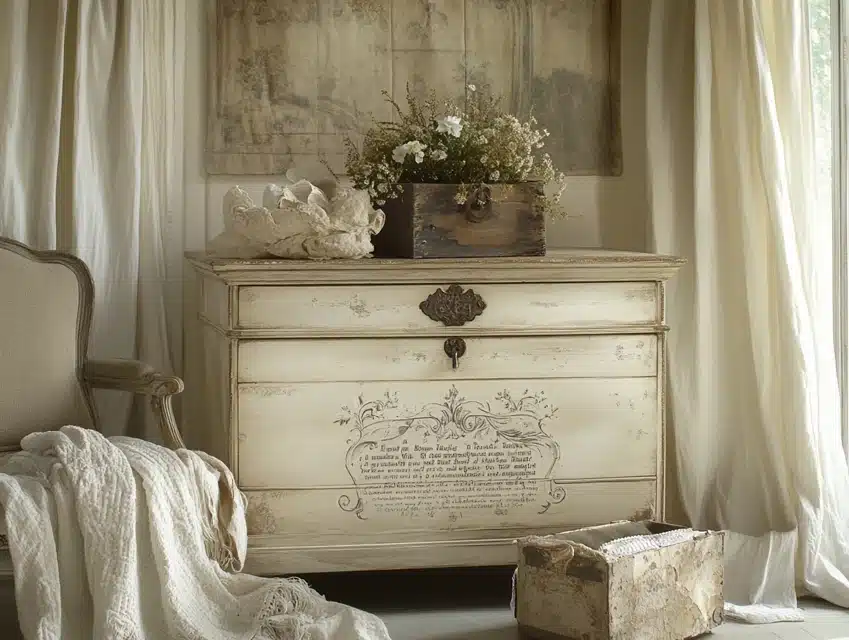
Creating this French-inspired piece changed my approach to vintage finishes forever.
The soft cream base color provided the perfect backdrop for delicate French script.
Hand-stenciled French poems wrapped around the chest like ancient letters.
Subtle aging techniques gave the piece an authentic European character.
This transformation inspired dozens of similar commissions over the years.
Even French clients praise the authentic vintage Parisian appearance.
Each detail contributes to the story of an imagined French antique piece.
DIY Steps:
- Apply vintage cream base color in multiple layers.
- Create custom French script stencils with proper spacing.
- Position text elements always using careful measurement techniques.
- Add age-appropriate wear patterns to specific areas carefully.
- Layer dark wax into corners for a time-worn appearance.
- Apply light distressing to raised areas methodically.
- Seal with a specialized vintage-finish protective coating.
18. Animal Print Adventure
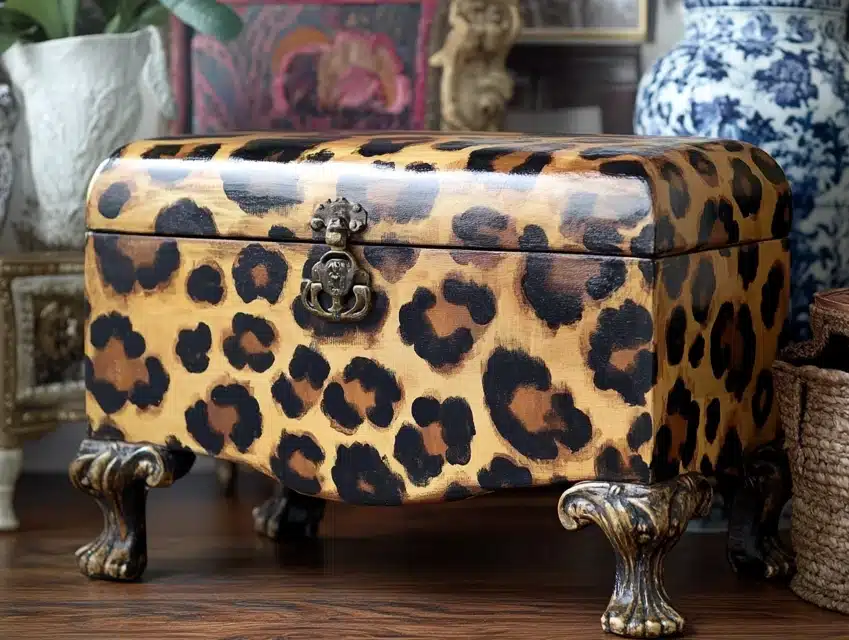
This bold transformation started as a request from a fashion-forward client.
The leopard print pattern required careful planning for its natural appearance.
Each spot needed unique characteristics to avoid looking manufactured.
The neutral color palette kept the dramatic pattern surprisingly versatile.
This chest proves that animal prints can be both sophisticated and playful.
DIY Steps:
- Create a perfect base tone with specialized texture primer.
- Layer different brown shades systematically for depth appearance.
- Paint each spot pattern with unique characteristics carefully.
- Build shadows around spots for dimensional effect properly.
- Add highlight details to create a realistic fur appearance.
- Blend edges between spots using special brush techniques.
- Apply a matte protective finish to maintain a natural look.
19. Metallic Panel Enhancement
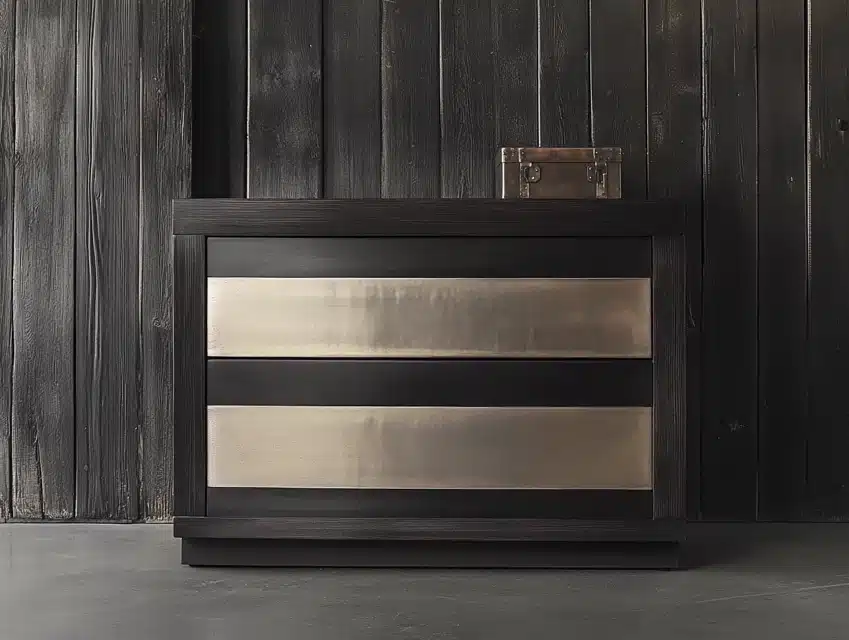
This project began as an experiment in mixing finishes and textures.
The main body received a deep charcoal paint treatment.
Metallic silver panels created stunning contrast against the dark background.
Special attention to panel edges ensured clean lines between finishes.
The combination of matte and metallic created unexpected visual drama.
DIY Steps:
- Prepare surfaces differently for each finish application.
- Apply a dark base coat to non-metallic areas first.
- Mask panel areas with extreme precision techniques.
- Layer metallic paint for proper coverage carefully.
- Remove masking while maintaining crisp edge lines.
- Add protective coating suitable for both finishes.
- Create adequate care instructions for dual finishes.
20. Beach-Inspired Weathered Finish
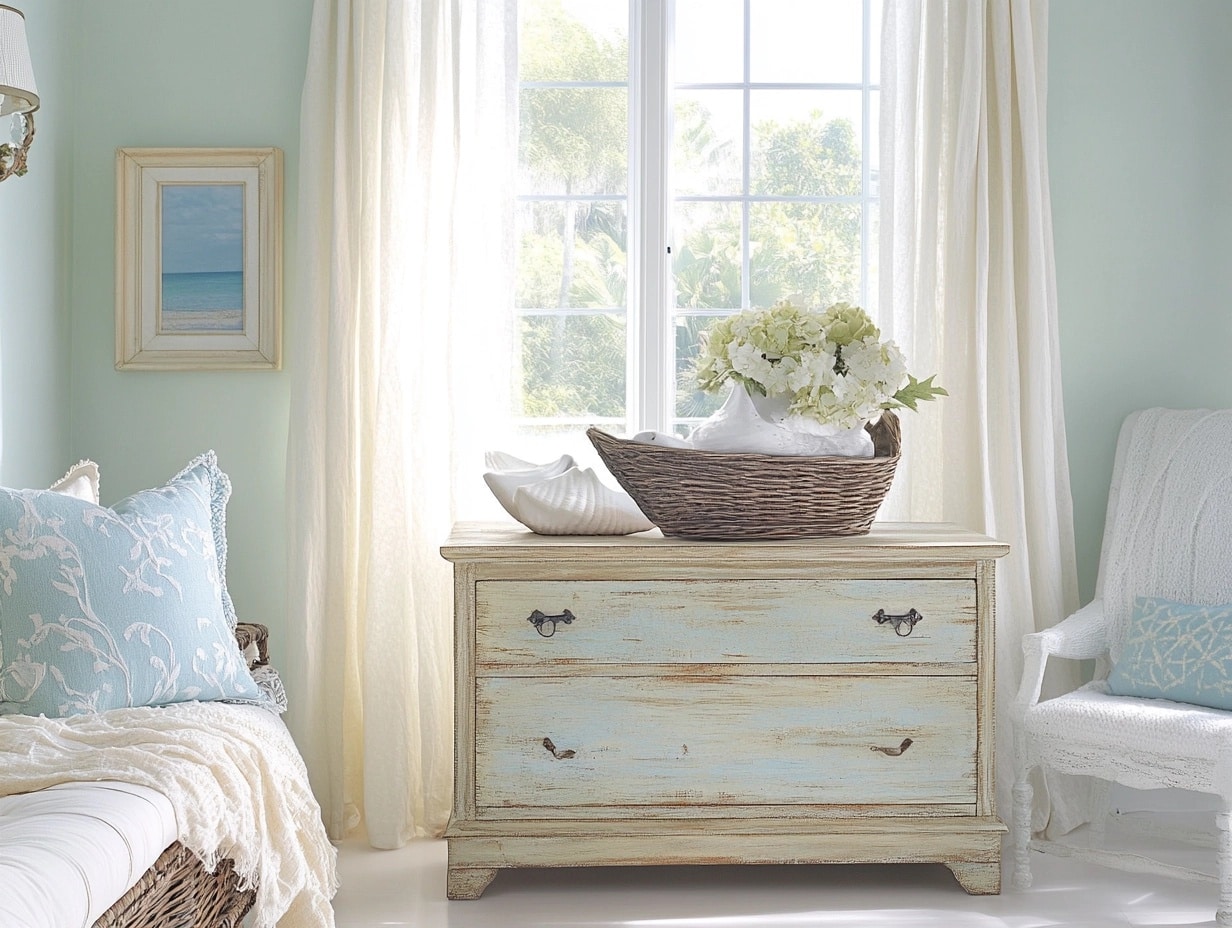
My coastal living experience inspired this naturally aged appearance.
The combination of sandy beige and weathered blue captured the perfect beach essence.
Special techniques mimicked the effects of years of salt air exposure.
White-washed areas suggested sun-bleached wood along shorelines.
This finish became my signature style for coastal home projects.
The chest brings immediate beach memories to any space.
Even inland clients request this authentic coastal weathering effect.
DIY Steps:
- Create base texture using specialized wood treatment techniques.
- Layer multiple colors for an authentic weather-worn appearance.
- Apply the white-washing effect in strategic areas carefully.
- Build depth through progressive color application methods.
- Add subtle sand texture in specific areas methodically.
- Create a salt-spray effect using a specialized finishing technique.
- Seal with marine-grade protective coating thoroughly.
21. Natural Top Preservation
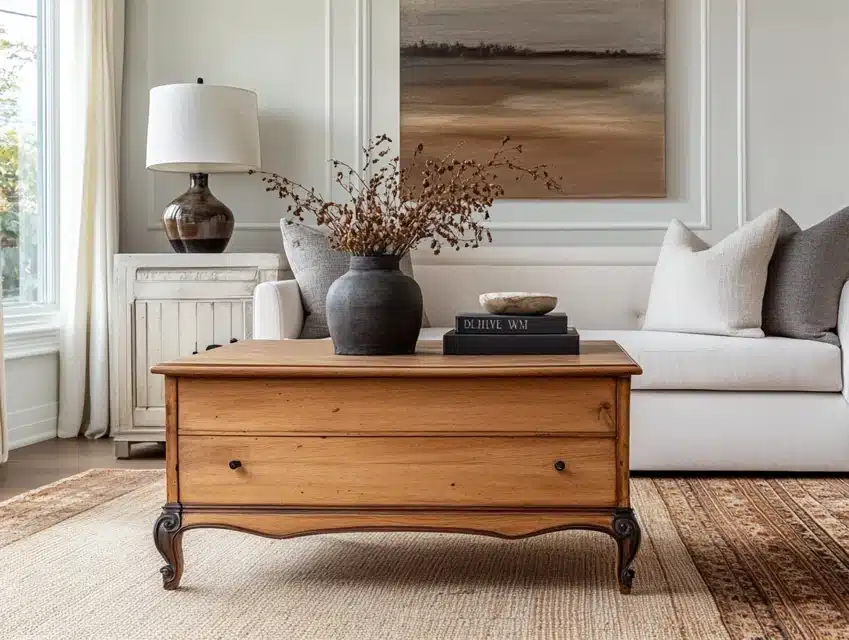
This design celebrates the perfect balance between old and new.
The natural cedar top maintains its beautiful grain and protective properties.
Careful sanding revealed stunning wood patterns hidden under years of wear.
The painted base provides a modern style while honoring traditional elements.
This combination inspired many similar furniture transformations afterward.
DIY Steps:
- Sand cedar tops carefully to reveal natural beauty.
- Apply specialized stain to enhance the wood grain pattern.
- Protect unpainted areas during the base color application process.
- Create a clean transition line between finishes precisely.
- Build up paint layers on the lower portion systematically.
- Add protective coating suitable for both surfaces.
- Create detailed care instructions for dual finishes.
Essential Maintenance Guide for Painted Cedar Chests
After years of creating and maintaining these pieces, I’ve developed specific care routines that ensure lasting beauty.
Let me share my proven maintenance approach.
Daily Care Tips
Regular maintenance prevents most common issues:
- Dust with soft microfiber cloth only
- Avoid direct sunlight exposure
- Maintain consistent room temperature
- Use proper coasters under items
- Check for moisture immediately
Seasonal Maintenance
I recommend these quarterly care steps:
- Deep clean surfaces with appropriate cleaners
- Inspect for wear patterns or damage
- Touch up any chips or scratches
- Check hardware tightness
- Apply protective wax if needed
Long-Term Protection
For lasting beauty, consider:
- Annual professional touch-ups for heavy-use pieces
- Refinishing every 5-7 years as needed
- Regular hardware maintenance
- Careful moving and placement
- Protection from environmental factors
Special Finish Care
Different finishes need specific attention:
- Chalk Paint: Regular waxing every 6 months
- Metallic Finishes: Avoid abrasive cleaners
- Distressed Finishes: Touch-up wear naturally
- Clear Coats: Check for clouding or peeling
- Specialty Finishes: Follow custom care instructions
Remember, proper care extends the life and beauty of your painted cedar chest while preserving its cherished contents.
Conclusion
After transforming hundreds of cedar chests, I’ve learned that successful painting combines proper preparation, quality materials, and patience.
Each piece offers unique opportunities for creative expression while maintaining its practical purpose.
Remember these key points:
- Test all products before full application
- Take time with preparation steps
- Document your process for future touch-ups
- Consider the piece’s environment
- Maintain proper ventilation during painting
- Follow manufacturer instructions carefully
- Create proper maintenance routines
Whether choosing classic whites or bold patterns, your painted cedar chest can become a functional storage piece and a stunning design element in your home.
Frequently Asked Questions
What Are Some Creative Ideas for Painting a Cedar Chest?
From my experience, popular options include classic white for versatility, bold geometric patterns for modern spaces, or distressed finishes for farmhouse style.
Consider your room’s existing decor and the chest’s future use.
Start with simpler designs before attempting complex patterns or techniques.
What Kind of Paint Is Best for Cedar Wood?
I always recommend starting with an oil-based primer specifically designed for cedar.
For the topcoat, chalk paint works beautifully for vintage looks, while latex or oil-based paints provide durability for frequent use.
Test your chosen paint on a hidden area first to ensure proper adhesion.
Will Painting a Cedar Chest Affect Its Cedar Aroma or Value?
In my restoration work, I’ve found that painting only the exterior maintains the internal cedar scent.
While painting might affect antique value, thoughtful transformation can increase the resale value of newer pieces.
Always document the original condition if the value is a concern.
How Do I Prepare the Chest for Painting?
Proper preparation is crucial. Clean thoroughly with wood cleaner, sand the surface carefully, and remove all dust.
Apply wood filler to any damaged areas and sand again.
Most importantly, a primer designed for cedar should be used to prevent tannin bleed-through.
Can I Preserve the Inside While Painting the Outside?
Absolutely! I always protect the interior during exterior painting.
Use painter’s tape and paper to cover the inside edges completely.
This preserves the cedar aroma and the chest’s storage functionality while allowing for exterior transformation.

